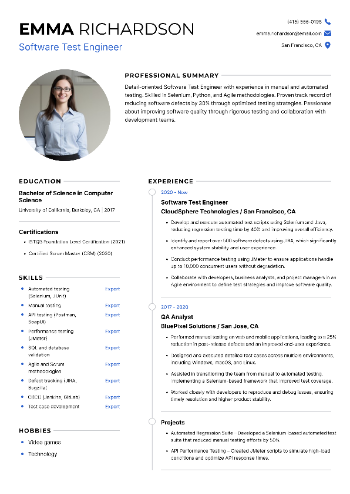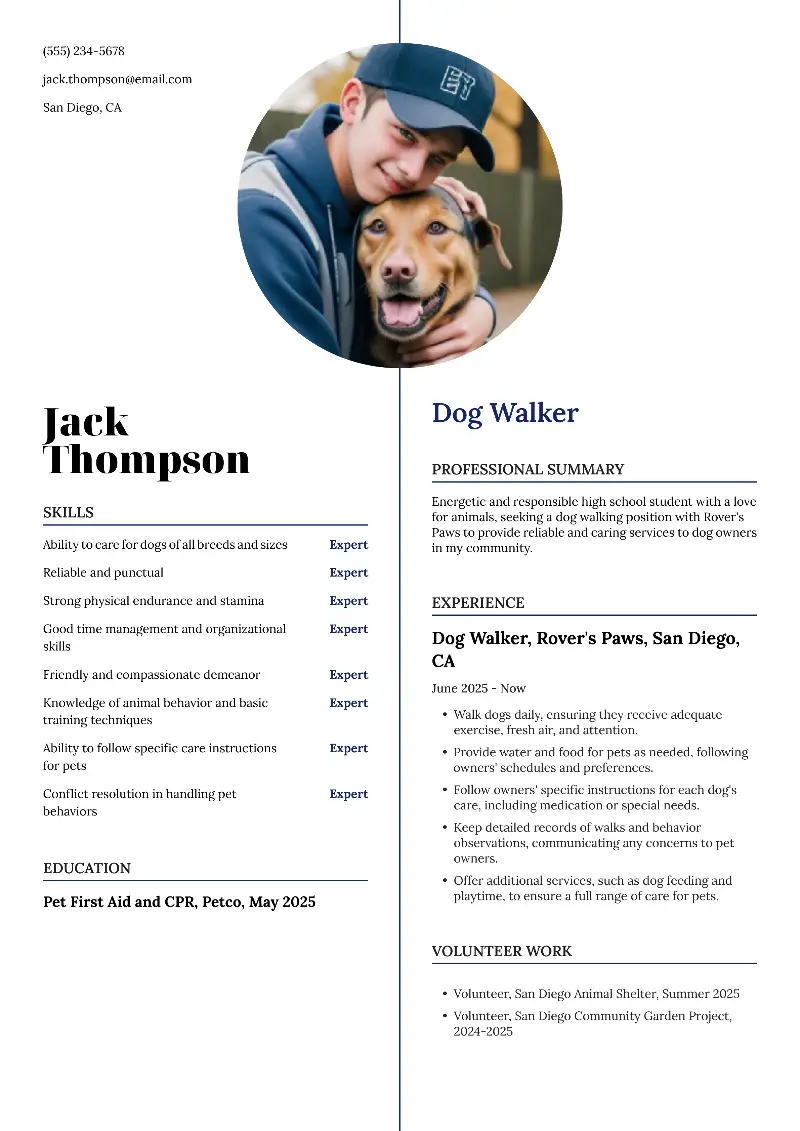Engineering skills for resume writing can make or break your chances in a competitive job market.
Whether you're a mechanical, software, or civil engineer, the way you showcase your skills in resume can influence how recruiters perceive your potential.
In this article, we’ll walk you through the top skills for an engineering resume that employers value, examples of how to include them effectively, and tips to write your resume to tailor it the description.
Why do engineering skills matter for a resume?
For hiring managers, the engineer skills you add can signal whether you’re ready to jump into their specific position or not. Here's why this section of resume needs to be more than a generic list.
Customizing Engineering Skills for Each Application
Every company looks for a slightly different mix of abilities depending on their industry, tools, and current projects.
A civil engineering role at a construction firm might prioritize AutoCAD and site planning, while a robotics startup may emphasize embedded systems and Python.
- Your goal?
- Match your expertise with what the employer actually needs.
Instead of using vague entries like “design” or “team player,” be direct. If a posting calls for “finite element analysis” or “SolidWorks,” those exact terms should appear in your resume—preferably supported by real achievements in resume.
Pull language directly from the job posting and echo it throughout your document.
How Recruiters Review Your Resume
Most companies rely on applicant tracking systems (ATS) to filter through submissions before a recruiter ever opens a file. These programs scan your file for strong keywords in resume related to the role.
That means even if you’re the ideal candidate, using the wrong phrasing—like writing “computer-based drafting” instead of “AutoCAD”—can keep your document from reaching the right people. To get past the filters:
- Use the exact keywords found in the listing.
- Place them naturally in your skills section, resume summary, and professional history.
- Make sure terminology reflects what’s current in the field.
Balancing Skills Needed to Be an Engineer
Your technical know-how proves you can do the job—but your interpersonal qualities show how you’ll perform within a team, communicate across departments, and stay cool under pressure.
Technical competencies:
- PLC configuration
- Circuit board layout
- Java, Python, or MATLAB
- Structural analysis
People-oriented capabilities:
- Clear reporting and documentation
- Time-sensitive decision making
- Leadership in cross-functional groups
- Collaboration in agile environments
The most effective resumes weave these elements together. You’re not just listing tools—you’re showing how you use them. For example:
Collaborated with electrical engineers and architects to redesign lighting systems using Revit, resulting in a 10% reduction in material costs.
Create your professional Resume in 10 minutes for FREE
Build My Resume
Top engineering resume skills
1. Computer-Aided Design (CAD)
- Best For: Mechanical Engineers, Civil Engineers, Product Designers, Architectural Engineers
CAD software is used to create precise 2D and 3D technical drawings for product designs, machinery layouts, and building plans. Mastery of tools like AutoCAD, SolidWorks, and Revit is essential in many engineering fields.
- How to learn these engineering skills?
- Online courses via Coursera or LinkedIn Learning, official software tutorials, and hands-on practice with projects.
Created 3D models of HVAC systems using SolidWorks, improving prototype efficiency by 20%.
2. MATLAB and Simulink
- Best For: Electrical Engineers, Mechanical Engineers, Mechatronics Specialists, Research Engineers
MATLAB is a powerful environment for data modeling, simulations, and system testing. Simulink extends this by allowing engineers to create block-based representations of dynamic systems for real-time analysis.
- How to learn these skills of an engineer?
- Take the official MATLAB Academy courses, enroll in university-level engineering programs, or practice with Simulink examples from MathWorks.
Simulated PID controller performance in MATLAB/Simulink to optimize engine response in hybrid vehicle prototypes.
3. Programming Languages (Python, C++, Java)
- Best For: Software Engineers, Robotics Engineers, Embedded Systems Engineers, Data Engineers
Programming is used for automation, data analysis, algorithm development, and hardware interfacing. Python is ideal for scripting and analytics, while C++ and Java are standard in system-level and embedded environments.
- How to learn these engineering skills?
- Practice through FreeCodeCamp or Codecademy, take Harvard’s CS50 or project-based GitHub repositories, and solve real-world problems.
Automated equipment calibration processes using Python, reducing manual input errors by 30%.
4. Finite Element Analysis (FEA)
- Best For: Aerospace Engineers, Structural Engineers, Mechanical Engineers, R&D Engineers
FEA is used to simulate how materials or products react under stress, heat, vibration, and other physical effects. ANSYS and Abaqus are standard tools for virtual testing before physical prototyping.
- How to learn these engineering skills?
- Use ANSYS Learning Hub, follow guided simulations on SimScale, or take mechanical analysis courses on Udemy.
Performed thermal stress analysis on aerospace turbine blades using ANSYS, identifying high-risk zones pre-manufacture.
5. Project Lifecycle Management (PLM)
- Best For: Manufacturing Engineers, Design Engineers, Industrial Engineers, Product Managers
PLM systems track a product’s development from design through disposal. Tools like Siemens Teamcenter and PTC Windchill allow engineers to manage design changes, documents, and workflows collaboratively.
- How to learn these engineering skills?
- Enroll in vendor-specific certification courses, take Udemy classes on Windchill or Teamcenter, or train on company systems.
Implemented PTC Windchill for BOM management, reducing revision tracking errors by 40%.
6. Electrical Circuit Design
- Best For: Electrical Engineers, Electronics Engineers, Hardware Developers, IoT Engineers
Circuit design involves building and testing electronic systems using PCB software such as Altium Designer, OrCAD, or LTspice. This skill is critical in consumer electronics, automotive systems, and industrial equipment.
- How to learn these engineering skills?
- Explore tutorials via Altium Designer Academy, practice on Arduino projects, or take electrical engineering courses with hands-on labs.
Developed PCB layouts for medical monitoring devices using Altium, cutting production time by two weeks.
7. PLC Programming and Industrial Automation
- Best For: Automation Engineers, Controls Engineers, Industrial Engineers, Maintenance Technicians
PLCs are used to automate mechanical processes in manufacturing. Programming skills in Siemens S7 or Allen-Bradley systems, along with ladder logic and HMI configuration, are crucial for factory automation.
- How to learn these engineering skills?
- Start with Siemens TIA Portal or Rockwell Automation courses, or try PLC simulators like Factory I/O or LogixPro.
Programmed Siemens S7 PLCs to control assembly line operations, reducing downtime by 18%.
8. 3D Printing and Additive Manufacturing
- Best For: Mechanical Engineers, Product Designers, Biomedical Engineers, R&D Engineers
Additive manufacturing enables fast prototyping and custom parts production. Understanding design constraints, print settings, and materials allows for efficient development of low-volume or complex items.
- How to learn these engineering skills?
- Use Autodesk Fusion 360, follow YouTube tutorials, or enroll in additive manufacturing courses via Udemy or edX.
Designed custom jigs for assembly line using FDM 3D printing, cutting lead time from 5 days to 1.
9. Data Analysis and Visualization
- Best For: Process Engineers, Quality Engineers, Energy Analysts, Systems Engineers
Engineers use data to assess efficiency, monitor systems, and improve designs. Excel, Tableau, and Python (Pandas, Matplotlib) are used to collect, analyze, and present technical data effectively.
- How to learn these engineering skills?
- Take Python for Data Science via DataCamp, master Excel on LinkedIn Learning, or build dashboards with Tableau Public.
Analyzed production downtime data using Pandas and visualized bottlenecks in Tableau dashboards, increasing output by 12%.
10. Geotechnical and Structural Analysis Software
- Best For: Civil Engineers, Structural Engineers, Construction Engineers, Infrastructure Analysts
This software helps simulate foundation behavior, load distribution, and compliance with safety standards. Tools like STAAD.Pro, SAP2000, and GeoStudio are crucial for structural integrity assessments.
- How to learn these engineering skills?
- Join Bentley’s official training, take NPTEL civil engineering simulations, or work on sample bridge and foundation design projects.
Modeled wind loads on steel-frame warehouse using STAAD.Pro to ensure compliance with Eurocode standards.
Examples of engineering skills in a resume
Mechanical Engineer
Elena McCoy
Austin, TX | elena.mccoy@email.com | +1 (512) 555-0133 | LinkedIn.com/in/elenamccoySummary
Results-driven Mechanical Engineer with experience in product development, CAD modeling, and prototyping. Known for improving manufacturing efficiency through precision design and collaboration with cross-disciplinary teams.
Skills
- SolidWorks
- AutoCAD
- NX Siemens
- CATIA
- GD&T
- Finite Element Analysis (ANSYS)
- Root Cause Analysis
- Rapid Prototyping
- SAP ERP
- Technical Documentation
- DFM/DFA
- Project Lifecycle Management
Experience
Mechanical Design Engineer – Emerson Electric Co.
St. Louis, MO | Jan 2020 – Present
- Lead the mechanical design of HVAC components using SolidWorks, optimizing airflow systems to reduce energy consumption by 18%.
- Develop and test 3D-printed prototypes for early-stage product evaluations, accelerating design approval timelines by two weeks.
- Collaborate with electrical and software engineers to integrate mechatronic subsystems into new smart thermostat models.
- Create detailed BOMs and maintained design revision control through SAP PLM tools, ensuring traceability and compliance.
Junior Mechanical Engineer – Trane Technologies
Minneapolis, MN | Jul 2017 – Dec 2019
- Designed mechanical assemblies for commercial refrigeration units using AutoCAD and SolidWorks, contributing to 3 major product lines.
- Assisted in conducting failure analysis of compressor systems, identifying root causes and recommending long-term design fixes.
- Worked with the QA team to develop inspection procedures and reduce nonconformities during production.
- Produced detailed mechanical drawings and tolerancing documentation to support manufacturing in multiple locations.
Education
Bachelor of Science in Mechanical Engineering
University of Illinois Urbana-Champaign, IL
Certifications
- Certified SolidWorks Professional (CSWP) – Dassault Systèmes, 2024
- NX Mechanical Design Certification – Siemens, 2023
Additional Projects
Developed a lightweight drone frame using composite materials as a freelance engineering consultant. Integrated carbon-fiber struts and improved weight-to-strength ratio by 35%.
Electrical Engineer
Mateo Ramirez
San Jose, CA | mateo.ramirez@email.com | +1 (669) 555-0199 | GitHub.com/materamSummary
Versatile Electrical Engineer with hands-on experience in embedded systems, PCB design, and IoT hardware development. Strong coding background in C and Python for microcontroller and sensor integration.
Skills
- Altium Designer
- Eagle CAD
- LTspice
- Embedded C
- Python
- Raspberry Pi
- Arduino
- IoT Development
- Serial Protocols (I2C, SPI, UART)
- Oscilloscope Use
- JTAG Debugging
- Firmware Testing
- MATLAB
- KiCad
Experience
Embedded Systems Engineer – Texas Instruments
Dallas, TX | Apr 2021 – Present
- Design 4-layer PCBs for wearable health monitoring devices, ensuring compact layout and efficient power management.
- Develop firmware in Embedded C for TI microcontrollers, implementing calibration algorithms and data logging features.
- Conduct signal integrity analysis and resolve EMI issues during validation phases, securing FCC compliance on first attempt.
- Participate in Agile sprints and coordinate with teams across departments to launch multiple IoT-enabled products.
Electronics Engineer Intern – Qualcomm Technologies Inc.
San Diego, CA | Jan 2020 – Mar 2021
- Supported hardware design team by creating schematic blocks for LTE modem prototypes using Altium Designer.
- Built Python-based automation scripts for regression testing across embedded test platforms.
- Assisted with lab debug efforts using oscilloscopes and logic analyzers to validate board-level functionality.
- Contributed to firmware updates and documented testing results for QA sign-off.
Education
Bachelor of Engineering in Electrical Engineering
University of California, San Diego | La Jolla, CACertifications
- Python for Embedded Systems – Coursera, 2023
- Certified Altium Designer User – Altium Academy, 2021
- Arduino Masterclass – Udemy, 2020
Personal Projects
Built a smart irrigation system using Raspberry Pi and soil moisture sensors. Integrated MQTT communication and created a web dashboard for real-time control and analytics.
Civil Engineer
Anna Leclerc
Denver, CO | anna.leclerc.dev@gmail.com | +1 (303) 555-0175 | Portfolio: annalclrc.devSummary
Detail-oriented Civil Engineer with extensive experience in geotechnical investigations and structural analysis. Specializes in infrastructure development and earthquake-resistant design aligned with AASHTO and Eurocode.
Skills
- STAAD.Pro
- SAP2000
- AutoCAD Civil 3D
- Revit
- Soil Mechanics
- Seismic Design
- Load Calculations
- Site Assessments
- Foundation Engineering
- Drainage Design
- Geotechnical Reports
- Eurocode & AASHTO
- Primavera P6
- ArcGIS
Experience
Structural Engineer – AECOM
Denver, CO | Feb 2019 – Present
- Perform structural simulations for bridges and elevated roadways using STAAD.Pro, adhering to seismic zoning codes.
- Supervise geotechnical assessments and soil classification reports to support stable foundation planning.
- Prepare reinforced concrete and steel design specs, 3D models, and material takeoffs using Civil 3D and SAP2000.
- Manage coordination with city engineers and contractors, ensuring timelines are met and permitting is approved.
Civil Engineer – HDR, Inc.
Phoenix, AZ | Aug 2015 – Jan 2019
- Produced drainage and grading plans for highway projects involving complex topography and environmental impact studies.
- Conducted slope stability and retaining wall analyses using GeoStudio and provided recommendations for reinforcement.
- Reviewed submittals and issued field reports after site inspections, improving contractor compliance on public projects.
- Delivered reports aligned with DOT requirements and participated in stakeholder meetings during planning phases.
Education
Master of Engineering in Civil Engineering
Colorado School of Mines | Golden, COCertifications
- Construction Safety and Health – OSHA 30-Hour, 2023
- AutoCAD Civil 3D Certification – Autodesk, 2022
- STAAD.Pro Certified Analyst – Bentley Institute, 2021
Volunteer Work
Contributed to a clean water project with Engineers Without Borders in rural New Mexico. Supported terrain analysis and helped design support structures for a 2-mile gravity-fed pipe system.
Conclusion
Including the right engineering skills list for your resume is more than just a formality—it’s about presenting yourself as the perfect match for the role.
By combining technical expertise with strong problem-solving, communication, and project management abilities, you can create a document that grabs attention and gets results.
Always customize the section based on the job description, and use specific engineering skills examples to highlight your impact. With a strategic approach, your application will do more than pass the scan—it’ll stand out.
Create your professional Resume in 10 minutes for FREE
Build My Resume












